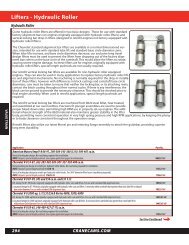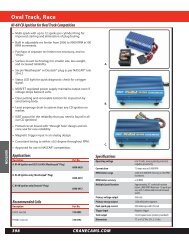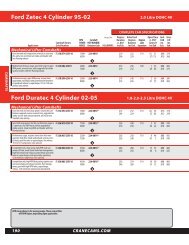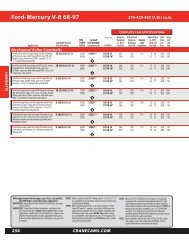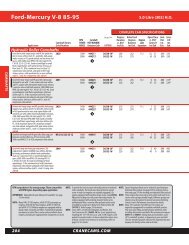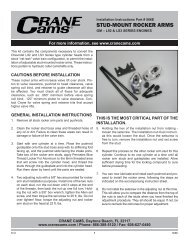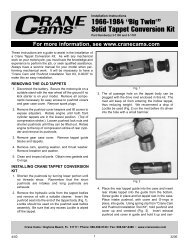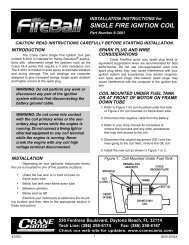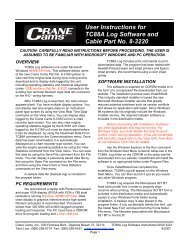pertains keyway optimal manufacturers’
DEGREEING A CAMSHAFT... THE EASY WAY. - Crane Cams
DEGREEING A CAMSHAFT... THE EASY WAY. - Crane Cams
You also want an ePaper? Increase the reach of your titles
YUMPU automatically turns print PDFs into web optimized ePapers that Google loves.
(1) The dial indicator may not be mounted rigidly (2) Thelifter may not be contacting the base circle solidly (3)The lifter could be sticking slightly in its bore. Find thetrouble and correct it before proceeding.It may be necessary to apply slight finger pressureagainst the lifter when rotating the engine. Be carefulnot to bump the pushrod.Any of these camshaft checks that may be performed (basecircle runout, cam timing, etc.) are also very dependent onyour cam bearings being in good condition and providingthe proper radial clearance for the type and size of bearing.Excessive radial clearance will distort your figures takenof tappet movement, resulting in incorrect conclusionsregarding the camshaft installation and its condition.CHECKING BASE CIRCLE RUNOUTThis is a good time to check for runout of the cam’s basecircle. This is out of roundness, or wobble, during rotation.If the cam lobe is concentric with the camshaft bearing journalsthere shouldn’t be any appreciable runout. We try tohold base circle runout to less than .001 inch for optimumcam performance and ease of setting lash. If the runout onyour cam measures more than .002” we suggest returning itto the manufacturer.If there is measurable base circle runout on your cam, adjustthe dial indicator so the runout is divided equally on bothsides of zero. This will give the minimum error for checkingthe cam’s timing.aggressive and the closing side being more gentle. Thereforewhen you attempt to locate the middle (or centerline) ofthe asymmetrical lobe there is an automatic error. It could beas little as 2° or as much as 6° depending on the actual lobedesign. Also, the centerline method does not really indicate ifyour camshaft was properly produced, as no confirmation ofthe duration occurs. Since the opening and closing at .050”lift method is not affected by the lobe design, it is more accurateto degree this way. This method will also verify youractual duration figures.When checking, always turn the engine in the normal directionof rotation because of possible slack in the timing chainor gear drive.DEGREEING YOUR CAMUsing the intake opening and closing at .050” cam lift,obtained from the information on your cam spec card (Figure5, K), turn the engine in the normal direction of rotation.Watch the dial indicator. When it moves up .050”, stop rotatingthe engine. Record the degree wheel number that thepointer is on. (In our example it is 12° BTDC, Figure 6). Thencontinue to rotate the engine in the same direction. Watchthe dial indicator, it will change direction at maximum lobelift. Record the cam lobe lift. Continue to rotate the engine inthe same direction until you reach .050” before closing. (Inour example it is 42° ABDC). (Figure 7) If you go past eitherof the .050” marks, back up at least .100” and rotate theengine in the normal direction again until you reach the .050”mark on the indicator.CAM SPECIFICATION CARDAll the information you need for checking the timing accuracyand phasing of a camshaft is provided on the specificationcard that you receive with your Crane cam. (Figure 5)This will include the opening and closing timing points andthe amount of lift (at the lifter) at which the timing should bechecked. (Figure 5, K)WHICH CAM DEGREEING METHOD TO USE?There are two popular methods for degreeing a cam: (1) usingthe opening and closing figures at .050” tappet lift off the basecircle of the cam; (2) using the intake centerline method.We believe that degreeing the cam using the opening andclosing at .050” lift is much more accurate. The problem withthe centerline method is it has you finding the theoreticalcenterline of the intake and/or exhaust lobe. It makes theassumption that the lobe you are checking is symmetrical,with its opening side being the exact same shape as theclosing side of the lobe. Most modern cam lobes are asymmetrical,with the opening side of the lobe being much moreFigure 65/10 4803



